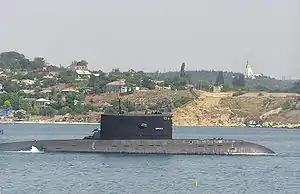Russian submarine B-871
Russian submarine B-871 Alrosa is a diesel-electric Kilo-class submarine that joined the Soviet Fleet in 1990 and was active with the Russian Black Sea Fleet as of 2011. In 2018, it was reported that the submarine would be transferred to the Baltic Fleet.[1] However, such a transfer had not occurred as of 2020. The submarine was still listed as active as of 2020.[2] It is now the only original Kilo-class boat (Project 877) remaining with the Black Sea Fleet with all other traditional Kilos in the Fleet having been replaced by the more modern "Improved Kilo" (Project 636.3) variant.
 B-871 Alrosa in 2006 | |
| History | |
|---|---|
| Name: | B-871 Alrosa |
| Commissioned: | 1990 |
| Status: | Active |
| General characteristics | |
| Class and type: | Kilo-class submarine |
| Displacement: |
|
| Length: | 76.2 m (250 ft) |
| Draught: | 6.5 m (21 ft) |
| Propulsion: |
|
| Speed: |
|
| Endurance: | 45 days |
| Test depth: | 300 m (980 ft) |
| Complement: | 52 |
| Armament: |
|
In June 2011 she took part in a NATO submarine rescue exercise, 'Bold Monarch 2011,' the first Russian submarine to do so.[3]
Instead of a conventional propeller Alrosa uses a pump jet propulsion system.[4]
History
The boat was laid down on 17 May 1988 in Gorky under yard number 607. Initially the boat was designed by 877V, included the provision of a water jet nozzle instead of a propeller. On 18 May 1989 boat crew was formed under the command of Captain 3rd Rank A. Yu Romanov.
On 10 September 1989 the boat was launched. In November of the same year, B- 871 Alrosa, using inland waterways, crossed the Black Sea and on 1 December 1990, the naval ensign was raised.
On 30 December 1990, B-871 became part of the 153rd Brigade of the Red submarines 14th submarine division of Black Sea Fleet based at the South Bay (Sevastopol).
From December 1991 - March 1992, the boat fulfilled its tasks of combat service. On 13 March 1992 the boats' crew swore allegiance to Ukraine and captured the boat.[5] Beginning 1992, B-871 was limited to dockside duty due to the lack of batteries.
In 1995 the submarine joined the 155th brigade of submarines. On 22 May 1996 after installing batteries, the boat joined the forces of permanent readiness. In August and September of the same year B-871 fulfilled the tasks of combat service with a rating of "excellent". Returning from deployment, she arrived in Novorossiysk, where she participated in the celebration of Navy Day.
In accordance with the Russian-Ukrainian agreement of 1997, the boat became part of the Russian Black Sea Fleet. On 19 September of the same year at the initiative of "Alrosa" and a number of veterans of the Navy signed an agreement on patronage over the boat stock company "Alrosa".
From August 1998 to April 1999 the vessel was held in Sevastopol for repairs. In January 2004, given the name of the B-871 Alrosa.
During August 2008 took part in fights off the Abkhazian coast and landed to Suhumi shore on pier.
On 5 August 2009, the submarine conducted deep tests after dock repairs. In the tests, the boat sank to the working depth - up to 240 metres (790 ft). On 21 November, while training in the Black Sea there was a failure of the propulsion system. The propulsion system failure may have included an "engine fire" requiring "Alrosa" in 2009 having to go to the Kronshtadt port near St. Petersburg for extensive repairs.
On 23 November Alrosa was towed to the Novorossiysk naval base.
In May -June 2011, Alrosa, together with support vessels, participated in an international exercises for rescue forces, called "Bold Monarch", held off the coast of Spain. After the exercise, in July, the boat made the transition to the Baltic Sea, where stood for scheduled maintenance in Kronstadt. In September 2012, she returned to Sevastopol after the scheduled maintenance.
The transition from the Baltic to the Black Sea took a little more than a month.
On 12 May 2013, Alrosa, together with the Ukrainian submarine Zaporizhzhia were present at the celebration of the 230th anniversary of the Black Sea Fleet in Sevastopol.
References
- https://iz.ru/773751/aleksei-ramm-bogdan-stepovoi/almaz-v-finskom-zalive
- https://www.kchf.ru/eng/ship/submarines/b871.htm
- "Nato's submarine rescue drills". BBC. 8 June 2011. Retrieved 8 June 2011.
- "B-871 Alrosa". Rusnavy.com. Retrieved 2016-08-28.
- ""Crimea should be Ukrainian, but without bloodshed." How Ukraine saved the peninsula 25 years ago". LB.ua (in Ukrainian). 16 July 2020.